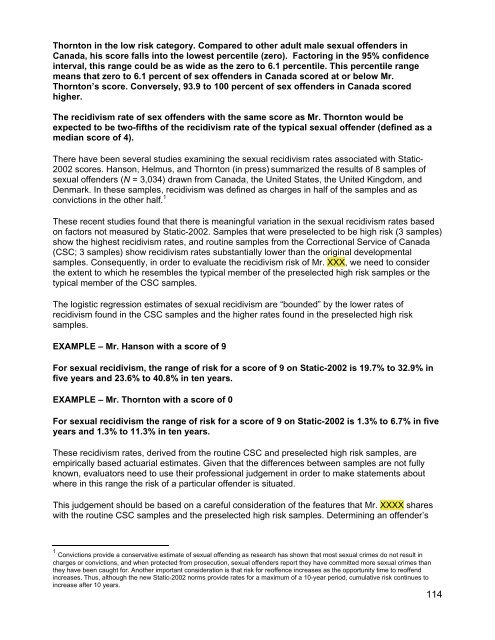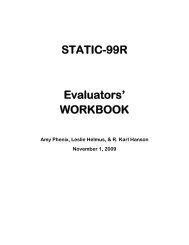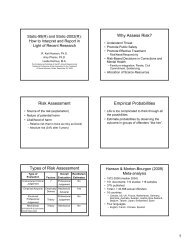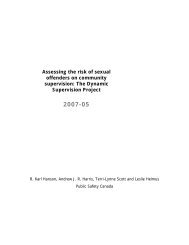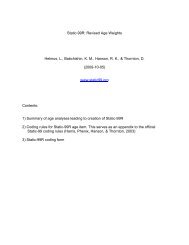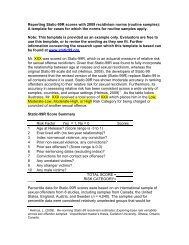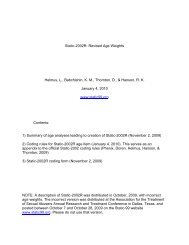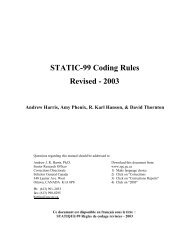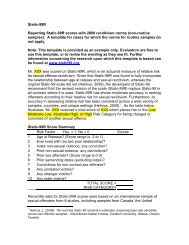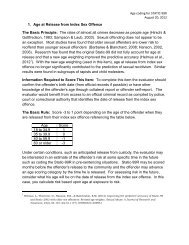Static-2002 coding rules (2009) - Static-99
Static-2002 coding rules (2009) - Static-99
Static-2002 coding rules (2009) - Static-99
Create successful ePaper yourself
Turn your PDF publications into a flip-book with our unique Google optimized e-Paper software.
Thornton in the low risk category. Compared to other adult male sexual offenders in<br />
Canada, his score falls into the lowest percentile (zero). Factoring in the 95% confidence<br />
interval, this range could be as wide as the zero to 6.1 percentile. This percentile range<br />
means that zero to 6.1 percent of sex offenders in Canada scored at or below Mr.<br />
Thornton’s score. Conversely, 93.9 to 100 percent of sex offenders in Canada scored<br />
higher.<br />
The recidivism rate of sex offenders with the same score as Mr. Thornton would be<br />
expected to be two-fifths of the recidivism rate of the typical sexual offender (defined as a<br />
median score of 4).<br />
There have been several studies examining the sexual recidivism rates associated with <strong>Static</strong>-<br />
<strong>2002</strong> scores. Hanson, Helmus, and Thornton (in press) summarized the results of 8 samples of<br />
sexual offenders (N = 3,034) drawn from Canada, the United States, the United Kingdom, and<br />
Denmark. In these samples, recidivism was defined as charges in half of the samples and as<br />
convictions in the other half. 1<br />
These recent studies found that there is meaningful variation in the sexual recidivism rates based<br />
on factors not measured by <strong>Static</strong>-<strong>2002</strong>. Samples that were preselected to be high risk (3 samples)<br />
show the highest recidivism rates, and routine samples from the Correctional Service of Canada<br />
(CSC; 3 samples) show recidivism rates substantially lower than the original developmental<br />
samples. Consequently, in order to evaluate the recidivism risk of Mr. XXX, we need to consider<br />
the extent to which he resembles the typical member of the preselected high risk samples or the<br />
typical member of the CSC samples.<br />
The logistic regression estimates of sexual recidivism are “bounded” by the lower rates of<br />
recidivism found in the CSC samples and the higher rates found in the preselected high risk<br />
samples.<br />
EXAMPLE – Mr. Hanson with a score of 9<br />
For sexual recidivism, the range of risk for a score of 9 on <strong>Static</strong>-<strong>2002</strong> is 19.7% to 32.9% in<br />
five years and 23.6% to 40.8% in ten years.<br />
EXAMPLE – Mr. Thornton with a score of 0<br />
For sexual recidivism the range of risk for a score of 9 on <strong>Static</strong>-<strong>2002</strong> is 1.3% to 6.7% in five<br />
years and 1.3% to 11.3% in ten years.<br />
These recidivism rates, derived from the routine CSC and preselected high risk samples, are<br />
empirically based actuarial estimates. Given that the differences between samples are not fully<br />
known, evaluators need to use their professional judgement in order to make statements about<br />
where in this range the risk of a particular offender is situated.<br />
This judgement should be based on a careful consideration of the features that Mr. XXXX shares<br />
with the routine CSC samples and the preselected high risk samples. Determining an offender’s<br />
1 Convictions provide a conservative estimate of sexual offending as research has shown that most sexual crimes do not result in<br />
charges or convictions, and when protected from prosecution, sexual offenders report they have committed more sexual crimes than<br />
they have been caught for. Another important consideration is that risk for reoffence increases as the opportunity time to reoffend<br />
increases. Thus, although the new <strong>Static</strong>-<strong>2002</strong> norms provide rates for a maximum of a 10-year period, cumulative risk continues to<br />
increase after 10 years.<br />
114


